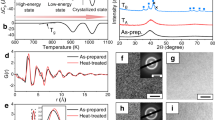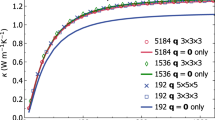Abstract
Glassy materials exist in nature and play a critical role in technology, but key differences between the glass, liquid and crystalline phases are not well understood. Over several decades there has been controversy about the specific heat absorbed as a glass transforms to a liquid—does this originate from vibrational entropy or configurational entropy? Here we report direct in situ measurements of the vibrational spectra of strong and fragile metallic glasses in the glass, liquid and crystalline phases. For both types of material, the measured vibrational entropies of the glass and liquid show a tiny excess over the crystal, representing less than 5% of the total excess entropy measured with step calorimetry. These results reveal that the excess entropy of metallic glasses is almost entirely configurational in origin, consistent with the early theories of Gibbs and co-workers describing the glass transition as a purely configurational transition.
This is a preview of subscription content, access via your institution
Access options
Access Nature and 54 other Nature Portfolio journals
Get Nature+, our best-value online-access subscription
$29.99 / 30 days
cancel any time
Subscribe to this journal
Receive 12 print issues and online access
$209.00 per year
only $17.42 per issue
Buy this article
- Purchase on Springer Link
- Instant access to full article PDF
Prices may be subject to local taxes which are calculated during checkout






Similar content being viewed by others
References
Gibbs, J. H. & DiMarzio, E. A. Nature of the glass transition and the glassy state. J. Chem. Phys. 28, 373–383 (1958).
Adam, G. & Gibbs, J. H. On the temperature dependence of cooperative relaxation properties in glass-forming liquids. J. Chem. Phys. 43, 139–146 (1965).
Goldstein, M. Viscous liquids and the glass transition: a potential energy barrier picture. J. Chem. Phys. 51, 3728–3739 (1969).
Debenedetti, P. G. & Stillinger, F. H. Supercooled liquids and the glass transition. Nature 410, 259–267 (2001).
Goldstein, M. Viscous liquids and the glass transition. V. Sources of the excess specific heat of the liquid. J. Chem. Phys. 64, 4767–4774 (1976).
Martinez, L.-M. & Angell, C. A. A thermodynamic connection to the fragility of glass-forming liquids. Nature 410, 663–667 (2001).
Gujrati, P. D. & Goldstein, M. Viscous liquids and the glass transition. 9. Nonconfigurational contributions to the excess entropy of disordered phases. J. Phys. Chem. 84, 869–873 (1980).
Johari, G. P. Contributions to the entropy of a glass and liquid, and the dielectric relaxation time. J. Chem. Phys. 112, 7518–7523 (2000).
Russew, K., Stojanova, L., Yankova, S., Fazakas, E. & Varga, L. K. Thermal behavior and melt fragility number of Cu100−xZrx glassy alloys in terms of crystallization and viscous flow. J. Phys. Conf. Ser. 144, 012094 (2009).
Yu, P., Bai, H. Y. & Wang, W. H. Superior glass-forming ability of CuZr alloys from minor additions. J. Mater. Res. 21, 1674–1679 (2006).
Angell, C. A. Spectroscopy simulation and scattering, and the medium range order problem in glass. J. Non-Cryst. Solids 73, 1–17 (1985).
Jiang, Q. K. et al. Zr–(Cu, Ag)–Al bulk metallic glasses. Acta Mater. 56, 1785–1796 (2008).
Syrykh, G., Zemlyanov, M. & Ishmaev, S. Experimental study of partial vibrational spectra in amorphous alloys. Physica B 234, 450–451 (1997).
Syrykh, G., Ishmaev, S., Zemlyanov, M. & Sashin, I. Concentration dependence of partial vibrational spectra in Ni-Nb and Cu-Zr metallic glasses. J. Non-Cryst. Solids 250, 642–644 (1999).
Suck, J. et al. Dynamical structure factor and frequency distribution of the metallic glass Cu46Zr54 at room-temperature. J. Phys. C 13, L167–L172 (1980).
Abernathy, D. L. et al. Design and operation of the wide angular-range chopper spectrometer ARCS at the Spallation Neutron Source. Rev. Sci. Instrum. 83, 015114 (2012).
Wallace, D. C. Statistical Physics of Crystals and Liquids (World Scientific, 2002).
Allen, P. B. Anharmonic phonon quasiparticle theory of zero-point and thermal shifts in insulators: heat capacity, bulk modulus, and thermal expansion. Phys. Rev. B 92, 064106 (2015).
Lind, M. L., Duan, G. & Johnson, W. L. Isoconfigurational elastic constants and liquid fragility of a bulk metallic glass forming alloy. Phys. Rev. Lett. 97, 015501 (2006).
Busch, R. The thermophysical properties of bulk metallic glass-forming liquids. JOM 52, 39–42 (2000).
Kubaschewski, O., Alcock, C. B. & Spencer, P. J. Materials Thermochemistry 6th edn (International Series on Materials Science and Technology, Pergamon, 1993).
Phillips, W. A., Buchenau, U., Nücker, N., Dianoux, A.-J. & Petry, W. Dynamics of glassy and liquid selenium. Phys. Rev. Lett. 63, 2381–2384 (1989).
Johari, G. P. The entropy loss on supercooling a liquid and anharmonic contributions. J. Chem. Phys. 116, 2043–2046 (2002).
Gjersing, E. L., Sen, S. & Aitken, B. G. Vibrational entropy near glass transition in a chalcogenide glass and supercooled liquid. J. Non-Cryst. Solids 355, 748–752 (2009).
Ohsaka, K. et al. Specific volumes of the Zr41.2Ti13.8Cu12.5Ni10.0Be22.5 alloy in the liquid, glass, and crystalline states. Appl. Phys. Lett. 70, 726–728 (1997).
Stillinger, F. H. A topographic view of supercooled liquids and glass formation. Science 267, 1935–1939 (1995).
Sciortino, F. Potential energy landscape description of supercooled liquids and glasses. J. Stat. Mech. 2005, P05015 (2005).
Arnold, O. et al. Mantid—data analysis and visualization package for neutron scattering and μ sr experiments. Nucl. Instrum. Methods Phys. Res. A 764, 156–166 (2014).
Sears, V., Svensson, E. & Powell, B. Phonon density of states in vanadium. Can. J. Phys. 73, 726–734 (1995).
de Wette, F. W. & Rahman, A. Inelastic scattering of neutrons by polycrystals. Phys. Rev. 176, 784–790 (1968).
Kresch, M., Delaire, O., Stevens, R., Lin, J. Y. Y. & Fultz, B. Neutron scattering measurements of phonons in nickel at elevated temperatures. Phys. Rev. B 75, 104301–104307 (2007).
Acknowledgements
The authors would like to acknowledge S. Randolph for her help with data collection. A portion of this research at Oak Ridge National Laboratory’s Spallation Neutron Source was sponsored by the Scientific User Facilities Division, Office of Basic Energy Sciences, US Department of Energy. This work benefited from DANSE software developed under NSF Grant No. DMR-0520547. This work was supported by DOE BES under contract DE-FG02-03ER46055.
Author information
Authors and Affiliations
Contributions
Samples were prepared by H.L.S., A.H., G.R.G., D.S.K. and M.D.D. Neutron data collection was performed by H.L.S., D.L.A., M.B.S., C.W.L., A.H., G.R.G., F.C.Y., M.S.L., T.S.-W. and B.F. Heat capacity measurements were carried out by H.L.S., A.H., G.R.G. and M.D.D. Data analysis was performed by H.L.S., C.W.L., D.S.K., J.Y.Y.L., M.D.D. and B.F. The manuscript was written by H.L.S., C.W.L. M.D.D. and B.F. All authors discussed the results and provided input on the paper.
Corresponding authors
Ethics declarations
Competing interests
The authors declare no competing financial interests.
Supplementary information
Supplementary information
Supplementary information (PDF 311 kb)
Rights and permissions
About this article
Cite this article
Smith, H., Li, C., Hoff, A. et al. Separating the configurational and vibrational entropy contributions in metallic glasses. Nature Phys 13, 900–905 (2017). https://doi.org/10.1038/nphys4142
Received:
Accepted:
Published:
Issue Date:
DOI: https://doi.org/10.1038/nphys4142
This article is cited by
-
Developing novel amorphous alloys from the perspectives of entropy and shear bands
Science China Materials (2023)
-
Dimensional ensemble and (topological) fracton thermodynamics: the slow route to equilibrium
Scientific Reports (2019)



